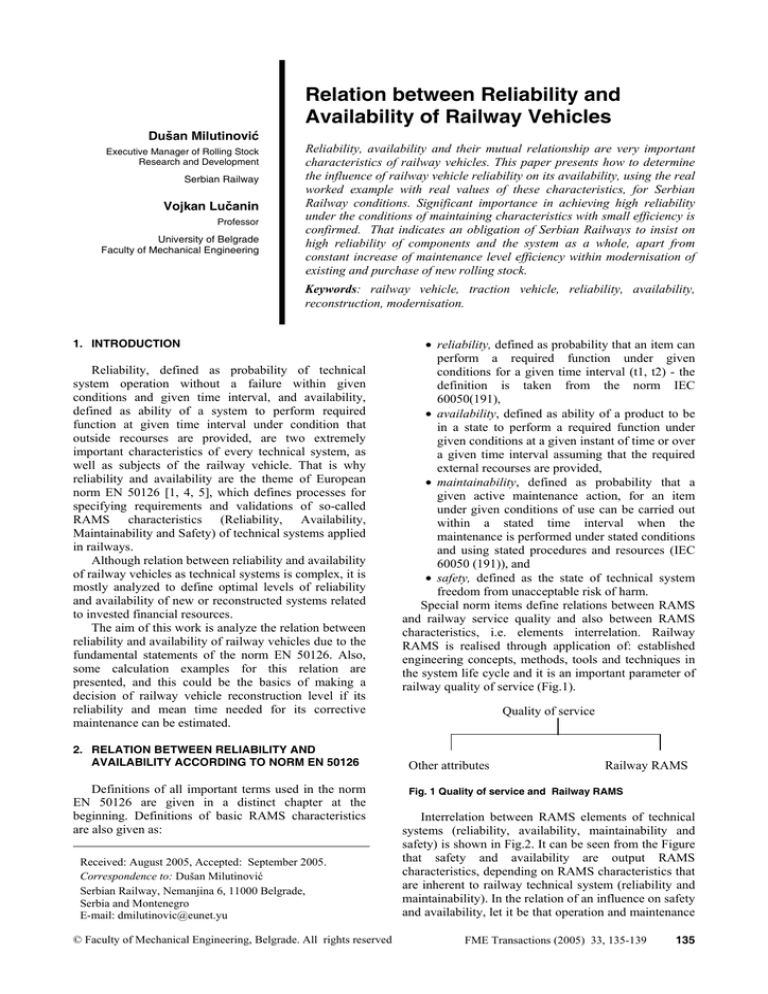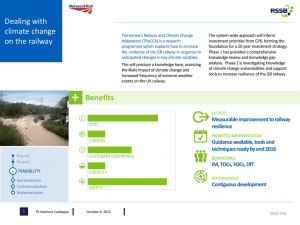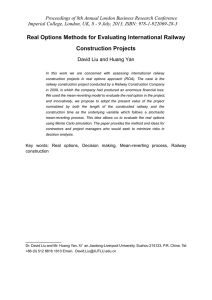
Relation between Reliability and
Availability of Railway Vehicles
Dušan Milutinović
Executive Manager of Rolling Stock
Research and Development
Serbian Railway
Vojkan Lučanin
Professor
University of Belgrade
Faculty of Mechanical Engineering
Reliability, availability and their mutual relationship are very important
characteristics of railway vehicles. This paper presents how to determine
the influence of railway vehicle reliability on its availability, using the real
worked example with real values of these characteristics, for Serbian
Railway conditions. Significant importance in achieving high reliability
under the conditions of maintaining characteristics with small efficiency is
confirmed. That indicates an obligation of Serbian Railways to insist on
high reliability of components and the system as a whole, apart from
constant increase of maintenance level efficiency within modernisation of
existing and purchase of new rolling stock.
Keywords: railway vehicle, traction vehicle, reliability, availability,
reconstruction, modernisation.
1. INTRODUCTION
Reliability, defined as probability of technical
system operation without a failure within given
conditions and given time interval, and availability,
defined as ability of a system to perform required
function at given time interval under condition that
outside recourses are provided, are two extremely
important characteristics of every technical system, as
well as subjects of the railway vehicle. That is why
reliability and availability are the theme of European
norm EN 50126 [1, 4, 5], which defines processes for
specifying requirements and validations of so-called
RAMS characteristics (Reliability, Availability,
Maintainability and Safety) of technical systems applied
in railways.
Although relation between reliability and availability
of railway vehicles as technical systems is complex, it is
mostly analyzed to define optimal levels of reliability
and availability of new or reconstructed systems related
to invested financial resources.
The aim of this work is analyze the relation between
reliability and availability of railway vehicles due to the
fundamental statements of the norm EN 50126. Also,
some calculation examples for this relation are
presented, and this could be the basics of making a
decision of railway vehicle reconstruction level if its
reliability and mean time needed for its corrective
maintenance can be estimated.
2. RELATION BETWEEN RELIABILITY AND
AVAILABILITY ACCORDING TO NORM EN 50126
Definitions of all important terms used in the norm
EN 50126 are given in a distinct chapter at the
beginning. Definitions of basic RAMS characteristics
are also given as:
Received: August 2005, Accepted: September 2005.
Correspondence to: Dušan Milutinović
Serbian Railway, Nemanjina 6, 11000 Belgrade,
Serbia and Montenegro
E-mail: dmilutinovic@eunet.yu
© Faculty of Mechanical Engineering, Belgrade. All rights reserved
• reliability, defined as probability that an item can
perform a required function under given
conditions for a given time interval (t1, t2) - the
definition is taken from the norm IEC
60050(191),
• availability, defined as ability of a product to be
in a state to perform a required function under
given conditions at a given instant of time or over
a given time interval assuming that the required
external recourses are provided,
• maintainability, defined as probability that a
given active maintenance action, for an item
under given conditions of use can be carried out
within a stated time interval when the
maintenance is performed under stated conditions
and using stated procedures and resources (IEC
60050 (191)), and
• safety, defined as the state of technical system
freedom from unacceptable risk of harm.
Special norm items define relations between RAMS
and railway service quality and also between RAMS
characteristics, i.e. elements interrelation. Railway
RAMS is realised through application of: established
engineering concepts, methods, tools and techniques in
the system life cycle and it is an important parameter of
railway quality of service (Fig.1).
Quality of service
Other attributes
Railway RAMS
Fig. 1 Quality of service and Railway RAMS
Interrelation between RAMS elements of technical
systems (reliability, availability, maintainability and
safety) is shown in Fig.2. It can be seen from the Figure
that safety and availability are output RAMS
characteristics, depending on RAMS characteristics that
are inherent to railway technical system (reliability and
maintainability). In the relation of an influence on safety
and availability, let it be that operation and maintenance
FME Transactions (2005) 33, 135-139
135
conditions are at the same level as reliability and
maintainability.
c) Operation availability:
Ao =
Railway RAMS
MUT
,
MUT + MDTcm + MDTpm + MDTlog+ad
where:
Safety
Availability
Reliability and
maintainability
Operation and
maintenance
Figure 2. Interrelation between Railway RAMS elements
Special norm item shows and defines processes of
identifying factors that influence railway systems
RAMS characteristics. Those factors and their
influences are input data for RAMS requirements
specification for a system.
Three types of sources, or failure factors, influence
Railway RAMS systems:
• failure sources happen in the system in any phase
of life cycle, and are connected to its construction
(system conditions connected with its
characteristics),
• failure sources connected with system
exploitation (operating conditions), and
• failure sources connected with its maintenance
(maintenance conditions).
Those sources of system failure, i.e. factors that
influence railway RAMS, also have an influence on
each other. This norm gives detailed scheme of relations
between some influential factors (Fig. 3). Beside this, it
is necessary to introduce new factors specific for each
railway itself.
Safety and availability are RAMS characteristics of
higher level, if compared with reliability and
maintainability (see schemes in Fig. 1 and 2). In scheme
in Fig. 3 reliability is not explicitly shown, and is given
through a group of internal failures in technical system,
which includes regular and random errors that influence
safety and availability through system characteristics.
Hence, characteristics of safety and availability depend
on characteristics of system reliability, so it is important
to determine their interrelation in the earlier phase of
system life cycle.
Formulas for availability calculation of railway
vehicles are indirectly given in the norm EN 50126.
Particularly, availability definition, given in norm EN
50126 was taken from the norm IEC 60050 (191) [2]
where three types of availability are given, depending
on what is considered to be mean delay time. So, there
are defined:
a) Inherent availability:
Ai=
MUT
MTBF
,
=
MUT + MDTcm MTBF + MDTcm
b) Technical availability:
At=
MUT
,
MUT + MDTcm + MDTpm
136 ▪ VOL. 33, No 3, 2005
MUT
MTBF
MDTcm
MDTpm
– mean up time,
– mean time between failures,
– mean down time due to corrective
maintenance,
– mean down time due to preventive
maintenance,
MDTlog+ad – mean down time due to logistic and/or
administrative reasons.
Previous equations for calculation of availability
show that availability increase can be influenced by:
• reliability increase,
• decrease of repair frequency within maintenance
(preventive and corrective) and
• system down time decrease ( MDTpm , MDTcm i
MDTlog+ad ).
From previous equations it can be concluded that
influence of reliability on availability differs according
to availability type. Own availability level significantly
depends on reliability of technical system that was built
in during development and manufacture, and it is
important for the manufacturer. However, the influence
of manufacturer on availability and reliability is
decreasing if operational availability is observed, which
is important to a user. Those influences of manufacturer,
user, or carrier on availability have different directions
and are shown in Fig.4. Average availability levels of
modern railway vehicles, for all three types of
availability, are also shown in the same figure [3].
3. RELIABILITY AND AVAILABILITY RELATIONSHIPS OF RAILWAY VEHICLES
Relation between reliability and availability of
railway vehicles is basically the same as of other
complex technical systems. The difference is in display
of analysis results of that relation, taking into
consideration the fact that reliability of railway vehicles
is mostly expressed through mean failure for 105 or 106
km of running distance and rarely through mean time
between failures (MTBF). That is the reason to analyse
the influence of reliability on availability with variation
of reliability expressed through mean failure at 105 km
of running distance.
In order to input reliability R, which is expressed as
number of failure at 105 km of running distance, in
calculation of availability, it is necessary to set an
equation for mean up time (MUT) that depends on:
reliability R [No of failure /105 km], mean down time
MDT [day], which differs according to the type of
availability that we want to calculate, and running
distance within a year S [105 km], which is calculated as
multiplication of unit running distance for reliability
evaluation of 105 km. Accordingly, annual mean up
time of the vehicle is as follows:
FME Transactions
Figure 3. Factors influencing Railway RAMS
365 − S ⋅ R ⋅ MDT
MUT =
,
S⋅R
and availability is:
A=
365 − S ⋅ R ⋅ MDT
S ⋅ R ⋅ MDT
=1−
.
365
365
The final equation of availability calculation used to
analyze the influence of reliability ton availability, is a
well-known equation, where behind minus sign stands
relation of total down time and total observed time (in
this case 365 days).
The linear dependence of reliability and availability
is obtained, as it was expected. A diagram that presents
dependence of availability on reliability for several
different values of mean down time (MDT) is created
for railway traction vehicle and a real value of annual
running time S = 2 (2·105 km) (Fig. 5).
Diagram in Fig. 5 shows that, apart from significant
influence of reliability, there is also great influence of
mean down time on availability, so it is necessary to
mention the existence of additional considerably
complex connection between reliability and mean down
time. Namely, for complex technical systems with large
number of different failures, there is large dissipation of
down time round mean value because of different
duration time of corrective repairs for different types of
failures.
Accordingly, significant reliability decrease for
some system components can influence an increase of
mean down time.
However, disregarding what was previously said, the
diagram clearly shows significant influence of mean
down time on availability for low reliability values.
FME Transactions
Accordingly, efficient maintenance is extremely
important for low availability system. Maintenance
should provide short mean down time, and increase
availability in that way, although it is clear that mean
down time doesn’t depend only on efficiency of
maintenance system but also on built in design system
characteristics, i.e. convenience for maintenance. In that
way, for example, for the same reliability R, an increase
of mean down time for one day, decreases vehicle
availability by 0.055 (5.5%), which means that from
100 traction vehicles in rolling stock fleet, each day
more than 5 traction vehicles will be less in traffic.
Diagram also shows one drastic example of railway
traction vehicle with low reliability R = 30 failure/105
km (such low reliability can be seen at electric
Fig. 4 Availability types and average availability levels of
modern railway vehicles
VOL. 33, No 3, 2005 ▪ 137
Figure 5. Dependence of availability (A) from reliability (R) for different values of mean down time (MDT)
locomotive series JŽ 461, see diagram1 in Fig. 6) and
mean down time MDT = 6 days, which implies to
considerably inefficient maintenance. Availability for
that case is close to zero, which practically means that
locomotives are repaired, but they fail as soon as they
are released in traffic, so these locomotives are not
running at all. On the other hand, if reliability is
significantly improved2 to R = 3 failure/105 km, even if
maintenance is still inefficient (MDT = 6), relatively
high availability of A = 0,901 is achieved, i.e. over
90% of locomotives in traffic.
Fig. 7 Dependence of availability on mean down time for
subsystems that have different ratio MUT/MDT and for
the whole system
Figure 6. Number of defects for 100,000 km of running
distance of electric traction vehicles “Serbian Railway“ in
period from 1997 to 2003
Due to the consideration given above, it can be
concluded that in the reconstruction of existing and
buying new railway vehicles, high reliability of
components and whole vehicles are ultimative.
1
Regarding diagram in Fig.6, it should be mentioned that term
defect, in addopted and regulated terms on Serbian Railways [6],
means failure, which has as a consequence a need to replace vehicle
or failure that causes delay of passenger train for longer than 30 min
or freight train longer than 60 min.
2
To the value of agreed reliability for modernisation of electric
locomotives series JŽ 461
138 ▪ VOL. 33, No 3, 2005
Railway vehicles manufacturers have been dealing
with the problem of providing high reliability for years.
There is an example of company SIEMENS, which
takes number of measures to increase reliability during
development of its multiple unit sets with the goal to
increase their availability [3], and all according to
European norm EN 50126. Those measures are often
forced and are the consequence of implementation of
new concepts and technologies in modern multiply unit
sets,
• providing the same function on several modules
with the same type, which provides maintaining
of system function even if one of the modules
completely fails (application of parallel
connection, i.e. redundancies, or quasi-parallel
connection, or partial redundancy);
• connecting vehicle diagnostic system with all
components and sub-systems in train
communication network (TCN), and
FME Transactions
• providing of high modularity and unification,
which, thanks to significant reduction of spare
parts, should reduce maintenance costs.
SIEMENS also creates analyses of availability
dependence on mean down time for components and
system as a whole. Fig. 7 shows theoretic example [3]
for system that has three subsystems (straight lines 1-3)
with different ration of mean utilisation time and mean
down time for each subsystem (MUT / MDT = 250, 500
and 1000). Diagram shows significant influence of
previously discussed ratio to total availability.
Company SIEMENS gives high values of 98% for
iherent and 96% for technical availability in its
technical description of diesel multiple-unit set
DESIRO.
4. CONCLUSIONS
On the basis of defined procedure and carried
outglobal analysis of ratio between availability and
reliability of railway vehicles, the following
conclusions are:
1. Created dependence diagram of availability on
reliability and mean down time A = f(R, MDT ), for
Serbian Railway conditions, in real value ranges for
R and MDT, can be useful in making decisions
about a level of reconstruction of the existing
railway stock and about suppliers` offer for
purchase of new stock. Before making decision
about reconstruction level or modernisation, the
analysis of how reliability of different solutions
influences system availability has to be performed.
This is one of the basic criteria for evaluation of the
quality of the chosen solution, and it is always used
together with reconstruction or modernisation
(development and series production) cost analysis.
Decisions of reconstruction and modernisation level
are always difficult, and are usually made within
making technical part of a bidding documentation,
when optimal solution has to bi chosen with the
best possible ratio price-efficiency.
2. For real estimation of the influence of reliability on
availability in operation and maintenance
conditions on Serbian Railways, it is necessary to
collect suitable data from operation and
maintenance and do calculations of reliability and
availability for all series of rolling stock owned by
Serbian Railway. Initialisation, defining and
realising these activities could be done within
realisation of
already permitted researchdeveloping project “Increasing
maintenance
efficiency of Serbian Railway rolling stock” and it
would be very useful for further application of the
norm EN 50126 in Serbian Railway.
FME Transactions
REFERENCES
[1] IEC 62278 (EN 50126): Railway applications The specification and demonstration of Reliability,
Availability, Maintainability and Safety (RAMS),
2002.
[2] IEC 60050 (191): International Electrotehnical
Vocabulary, Chapter 191: Dependability and
quolity of service, 1990.
[3] Eberlein, M., Höfer, L.: The Development of Rail
Vehicles from the Perspective of Greater
Availability, RTR – Railway Technical Review,
International Journal for Railway Engineers, No.
2-3, pp. 112-121, 2002.
[4] Milutinović, D.: EN 50126 standard and safety
characteristics and its application in Serbian
Railway, “Železnice”, Vol. 60, No. 5-6, Beograd,
pp. 166-175, 2004, (in Serbian).
[5] Milutinović, D., Vukmirica, M.: Concept of risk in
European standard EN 50126 and application at
Serbian Railways, „Istraživanja i projektovanja za
privredu“, No. 3, pp. 53-60, Beograd, 2003, (in
Serbian).
[6] Train haul documenting and traction unit
maintenance on Yugoslav Railways manual
(Manual 236), Yugoslav Railways, Belgrade,
1984, (in Serbian).
____________________________________________
ОДНОС ПОУЗДАНОСТИ И
РАСПОЛОЖИВОСТИ ЖЕЛЕЗНИЧКИХ
ВОЗИЛА
Душан Милутиновић, Војкан Лучанин
Поузданост и расположивост железничких возила
су значајне карактеристике због чега је врло важно
утврђивање и њиховог међусобног односа. У раду
је дат приказ могућности одређивања утицаја
поузданости железничког возила на његову
расположивост на примеру који узима у обзир
реалне вредности тих карактеристика за услове
“Железница Србије”. Потврђен је велики значај
остварења високе поузданости возних средстава у
условима
њиховог
одржавања
са
малом
ефикасношћу. То, са своје стране, упућује на
обавезу “Железница Србије” да, поред сталног
подизања нивоа ефикасности одржавања, приликом
модернизације постојећих и набавке нових возних
средстава инсистира на високој поузданости
компонената и система у целини.
VOL. 33, No 3, 2005 ▪ 139




